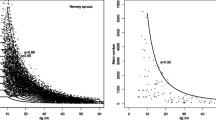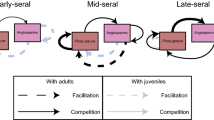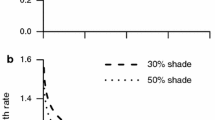Abstract
The competition-density effect of plant populations is of significance in theory and practice of forest management and has been studied for long time. The differences between the two reciprocal equations of the competition-density effect in nonself-thinning populations and self-thinning populations were analyzed theoretically. This supplies a theoretical basis for analyzing the dynamics of forest populations and evaluating the effect of forest management.
Similar content being viewed by others
References
Bleasdale, J.K.A. 1967. The relationship between the weight of a plant part and total weight as affected by plant density [J]. Journal of Horticultural Science,42: 51–58.
Bleasdale, J.K.A., Nelder, J.A. 1960. Plant population and crop yield [J]. Nature,188: 342.
Fang Jingyun, Kan, M., Yamakura, T. 1991. Relationships between population growth and population density in monocultures ofLarix leptolepis [J]. Acta Botanica Sinica,33: 949–957 (in Chinese).
Farazdaghi, H. and Harris, P.M. 1968. Plant competition and crop yield [J]. Nature,217: 289–290.
Hagihara, A. 1996. Logistic theory of the density effect in self-thinning populations [J]. Bulletin of the Nagoya University Forest,15: 31–50 (in Japanese).
Hagihara, A. 1999. Theoretical considerations on the C-D effect in self-thinning plant populations [J]. Research of Population Ecology,41: 151–159.
Kira, T., Ogawa, H., Shinozaki, K. 1953. Intraspecific competition among higher plants. I. Competition-yield-density interrelation-ship in regularly dispersed populations [J]. Journal of Institute of Polytechnics, Osaka City University, D4: 1–16.
Minowa, M. 1982. A theoretical approach to forest growth model. I. The log-Mitscherlich theory [J]. Journal of the Japanese. Forestry Society,64: 461–467 (in Japanese).
Naito, K. 1992. Studies on forest growth modeling [J]. Bulletin of Utsunomiya University Forest,28: 1–95 (in Japanese).
Nelder, J.A. 1962. New kinds of systematic designs for spacing experiments [J]. Biometrics,18: 283–307.
Shinozaki, K. 1961. Logistic Theory of Plant Growth [D]. Doctoral Thesis, Kyoto Univ., Kyoto (in Japanese).
Shinozaki, K., Kira, T. 1956. Intraspecific competition among higher plants. VII. Logistic theory of the C-D effect [J]. Journal of Institute of Polytechnics, Osaka City University,D 7: 35–72.
Vandermeer, J. 1984. Plant competition and the yield-density relationship [J]. Journal of Theoretical Biology,109: 393–399.
Watkinson, A.R. 1980. Density-dependence in single-species populations of plants [J]. Journal of Theoretical Biology,83: 345–357.
Watkinson, A.R. 1984. Yield-density relationships: the influence of resource availability on growth and self-thinning in populations ofVulpia fasciculate [J]. Annals of Botany,53: 469–482.
Xue Li, Hagihara, A. 1998. Growth analysis of the self-thinning stands ofPinus densiflora Sieb.et Zucc [J]. Ecological Research,13: 183–191.
Xue Li, Hagihara, A. 1999. Density effect, self-thinning and size distribution in ofPinus densiflora Sieb.et Zucc. Stands [J]. Ecological Research,14: 49–58.
Xue Li, Hagihara, A. 2001a. Growth analysis on the competition-density effect in Chinese fir (Cunninghamia lanceolata) and Masson pine (Pinus massoniana) stands [J]. Forest Ecology Management,150: 331–337.
Xue Li, Hagihara, A. 2001b. Growth analysis on the competition-density effect inCunninghamia lanceolata stands [J]. Chinese Journal of Applied Ecology,12: 171–174 (in Chinese).
Xue Li, Hagihara, A. Growth analysis on the C-D effect in self-thinning Masson pine (Pinus massoniana) stands [J]. Forest Ecology Management (in press).
Author information
Authors and Affiliations
Corresponding author
Additional information
Biography: XUE Li (1958-), male, Ph. Doctor, associate professor in College of Forestry, South China Agriculture University, Guangzhou 510642, P. R. China.
Responsible editor: Song Funan
Rights and permissions
About this article
Cite this article
Li, X. Competition-density effect in plant populations. Journal of Forestry Research 13, 48–50 (2002). https://doi.org/10.1007/BF02857145
Received:
Issue Date:
DOI: https://doi.org/10.1007/BF02857145




